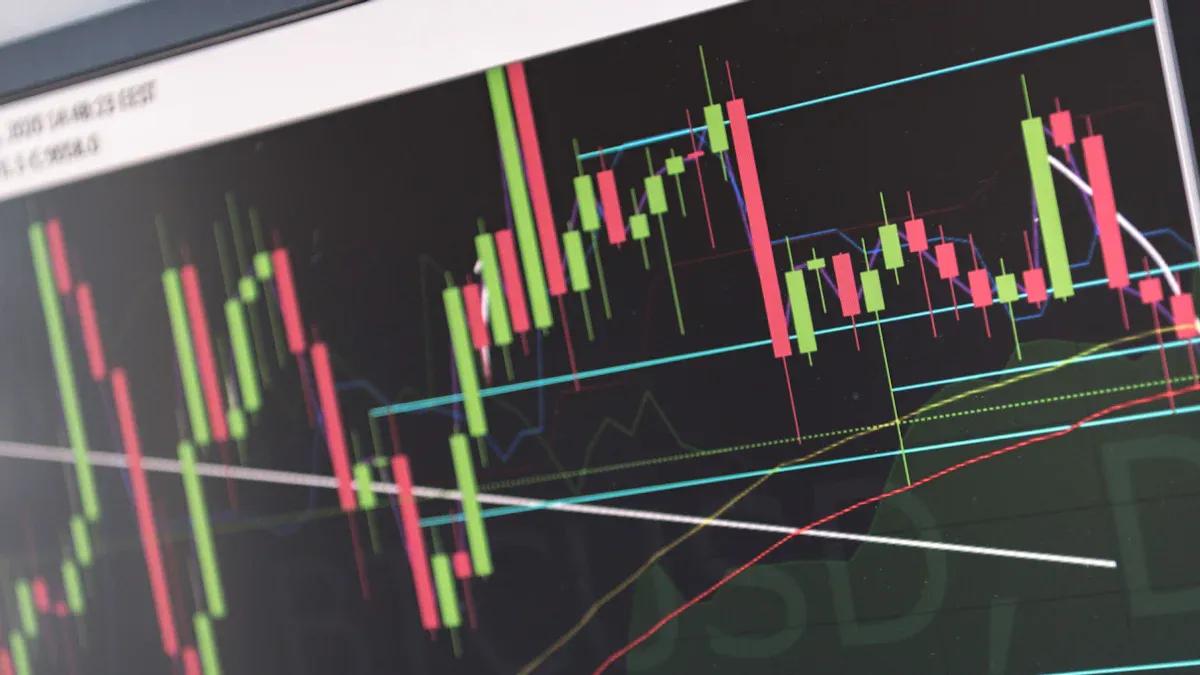- EasyCard
- Trade
- Help
- Announcement
- Academy
- SWIFT Code
- Iban Number
- Referral
- Customer Service
- Blog
- Creator
What is the Entrustment Ratio? Understanding Short-Term Market Sentiment from Buy and Sell Orders

Image Source: pexels
You often see the term “commission ratio” in stock trading software. What is the commission ratio? It is an indicator that measures the strength of buy and sell orders, helping you quickly assess short-term market sentiment. By observing whether the commission ratio is positive or negative, you can get a preliminary understanding of changes in buying and selling forces. The calculation of the commission ratio is simple: the closer the value is to +100%, the stronger the buying force; the closer it is to -100%, the stronger the selling force.
Key Points
- The commission ratio is an indicator that measures the strength of buy and sell orders, with a value range from -100% to +100%.
- A positive commission ratio indicates stronger buying force, while a negative commission ratio indicates stronger selling force, helping to quickly assess market sentiment.
- By observing changes in the commission ratio, you can capture shifts in short-term market sentiment to aid investment decisions.
- Combining it with other indicators like trading volume and price trends allows for a more comprehensive analysis of market conditions, avoiding one-dimensional judgments.
- Stay rational, avoid frequent trading due to short-term fluctuations, and develop a stable investment strategy.
What is the Commission Ratio
Definition
When trading stocks, you often encounter the question, “What is the commission ratio?” The commission ratio is an indicator used to measure the strength of buy and sell orders. You can see the commission ratio value in stock trading software. This value reflects the current balance of power between buyers and sellers in the market.
The commission ratio ranges from -100% to +100%. When you see a positive commission ratio, it indicates stronger buying force. When it is negative, it indicates stronger selling force. Through the commission ratio, you can quickly understand the status of buy and sell orders in the market.
What is the commission ratio? It is not the price or trading volume but a comparison of the number of pending orders. By glancing at the commission ratio, you can tell whether the market sentiment leans toward buyers or sellers.
Role
You can use the commission ratio to gauge short-term market sentiment. What is the commission ratio? It helps you understand the current balance of power between buy and sell orders.
When the commission ratio is close to +100%, it means buy orders significantly outnumber sell orders, indicating strong buying interest in the market. Conversely, when it is close to -100%, sell orders dominate, showing strong selling interest.
When analyzing the market, you can use the commission ratio as a supplementary indicator. It allows you to see short-term market changes more intuitively.
- If you want to know whether the market leans toward buyers or sellers, you can directly look at the commission ratio.
- If you want to capture changes in market sentiment, the commission ratio data provides a reference.
What is the commission ratio? It is your “thermometer” for understanding short-term market sentiment. You can combine it with other indicators to make a comprehensive judgment of market trends.
Commission Ratio Calculation

Image Source: pexels
Calculation Formula
When learning what the commission ratio is, the most important step is to understand its calculation method. The standard formula for the commission ratio is as follows:
Commission Ratio = (Buy Order Volume - Sell Order Volume) ÷ (Buy Order Volume + Sell Order Volume) × 100%
- Buy Order Volume: Refers to the total number of buy orders in the top five price levels in the market.
- Sell Order Volume: Refers to the total number of sell orders in the top five price levels in the market.
You can think of buy order volume and sell order volume as two “force values.” Using this formula, you can quickly calculate the balance of power between buyers and sellers.
For example, if the buy order volume is 8,000 shares and the sell order volume is 2,000 shares, then the commission ratio = (8,000 - 2,000) / (8,000 + 2,000) × 100% = 60%.
You simply plug the data into the formula to get the specific commission ratio value.
Meaning of Positive and Negative Values
How should you interpret a positive or negative commission ratio?
The commission ratio ranges from -100% to +100%. Different values represent different market sentiments:
| Commission Ratio Range | Market Implication | Description |
|---|---|---|
| +80% ~ +100% | Extremely Strong Buyers | Buy orders far exceed sell orders |
| +20% ~ +80% | Strong Buyers | Buy orders slightly exceed sell orders |
| -20% ~ +20% | Balanced Buying and Selling | Buying and selling forces are close |
| -20% ~ -80% | Strong Sellers | Sell orders slightly exceed buy orders |
| -80% ~ -100% | Extremely Strong Sellers | Sell orders far exceed buy orders |
You can use the positive or negative value of the commission ratio to gauge short-term market sentiment. For example, in the U.S. market, if a stock has a buy order volume of 10,000 shares and a sell order volume of 5,000 shares, the commission ratio = (10,000 - 5,000) / (10,000 + 5,000) × 100% = 33.3%. At this point, the buying force is stronger, and the market shows clear buying interest. Conversely, if the buy order volume is 3,000 shares and the sell order volume is 9,000 shares, the commission ratio = (3,000 - 9,000) / (3,000 + 9,000) × 100% = -50%. In this case, the selling force dominates, indicating stronger selling interest.
In practice, you can use the positive or negative value of the commission ratio to quickly assess changes in market sentiment. A positive commission ratio indicates stronger buying force, while a negative one indicates stronger selling force. You can combine it with other indicators to further analyze market trends.
Buy and Sell Orders and Commission Ratio

Image Source: unsplash
Concept of Buy and Sell Orders
When trading stocks, you often see buy and sell orders. Buy and sell orders refer to the buy or sell instructions entered by investors into the trading system in advance. These orders have not yet been executed, and the system arranges them by price and time priority. You can think of buy orders as pending orders to buy stocks that have not yet been executed and sell orders as pending orders to sell stocks that have not yet been executed.
In the U.S. market, trading software typically displays the top five buy and sell orders. Through these data, you can see the balance of power between buyers and sellers in the market. What is the commission ratio? It is an indicator calculated from these buy and sell order data, reflecting market sentiment. By observing changes in the number of pending orders, you can detect shifts in market sentiment.
When analyzing stocks, first look at the pending orders, then the commission ratio, to better understand the market’s buying and selling forces.
Sentiment Reflection
If you want to gauge short-term market sentiment, you can focus on the commission ratio. The commission ratio directly reflects the attitude of market participants through the number of buy and sell orders. If buy orders significantly outnumber sell orders, the commission ratio will be positive, indicating strong buying interest. Conversely, if sell orders dominate, the commission ratio will be negative, showing stronger selling interest.
You can use the following table to quickly assess market sentiment:
| Commission Ratio Range | Market Sentiment |
|---|---|
| +80% ~ +100% | Extremely Strong Buyers |
| -80% ~ -100% | Extremely Strong Sellers |
When you see a significant increase in buy orders for a stock in the U.S. market, the commission ratio will rise rapidly. In this case, the market may experience an upward movement driven by buy orders in the short term. By observing changes in pending orders and the commission ratio, you can promptly grasp shifts in market sentiment.
Commission Ratio Application
Data Interpretation
When analyzing stocks, you can use commission ratio data to quickly assess short-term market sentiment. A positive commission ratio indicates stronger buying force, while a negative one indicates stronger selling force. You can use the following table to quickly interpret the market implications of different commission ratio ranges:
| Commission Ratio Range | Market Sentiment | Reference Action |
|---|---|---|
| +80% ~ +100% | Extremely Strong Buyers | Focus on buying opportunities |
| +20% ~ +80% | Strong Buyers | Cautiously bullish |
| -20% ~ +20% | Balanced Buying and Selling | Mainly observe |
| -20% ~ -80% | Strong Sellers | Cautiously bearish |
| -80% ~ -100% | Extremely Strong Sellers | Watch for selling risks |
You can think of the commission ratio as a market “thermometer.” When you see rapid changes in the commission ratio during trading, it may indicate a shift in market sentiment. You can combine it with trading volume, price trends, and other indicators to comprehensively judge the timing of buying or selling.
Tip: The commission ratio reflects pending orders, not actual transactions. You need to combine more data to avoid one-dimensional judgments.
Application Scenarios
When trading in the U.S. market, you can use the commission ratio to assist in decision-making. For example, if you see a commission ratio of +90% for a tech stock before the market opens, with buy orders far exceeding sell orders, you can infer that buying interest is strong after the market opens, and the stock price may rise in the short term. You can also monitor commission ratio changes during trading. If the commission ratio shifts from positive to negative, it indicates a reversal in market sentiment with stronger selling force, and you may consider adjusting your holdings.
When using the U.S. stock trading services of a licensed Hong Kong bank, you can also refer to commission ratio data. If you see a stock with a commission ratio of -85%, with a significant increase in sell orders, you can combine market news and company announcements to determine whether negative news is affecting market sentiment. In practice, combining the commission ratio with other technical indicators allows you to develop more scientific buying and selling strategies.
Commission Ratio Limitations
Limitations
When analyzing the market, you cannot rely solely on the commission ratio. The commission ratio reflects the number of buy and sell orders but cannot reveal the true intentions behind actual transactions. Many investors may temporarily cancel orders or frequently adjust pending orders, causing fluctuations in the commission ratio data. You also need to note that the commission ratio only focuses on the top five price levels of orders, failing to fully reflect the entire market depth.
In some cases, institutional investors may influence the commission ratio through large orders to create false market sentiment. If you only look at the commission ratio, you may be misled. The commission ratio also cannot predict long-term price trends and only reflects short-term sentiment. In practice, you should combine trading volume, price trends, fund flows, and other indicators to comprehensively judge market direction.
Tip: The commission ratio is suitable as a supplementary reference for market sentiment, not as the sole basis for buying or selling decisions.
Precautions
When using the commission ratio, you need to remain rational and cautious. The following suggestions can help you avoid misjudgments:
- Adopt rational and stable investment strategies, avoiding frequent trading due to short-term commission ratio changes.
- Do not chase high prices for speculation, and avoid blindly following market sentiment.
- Understand the market’s interest rate risks and liquidity risks, and recognize that investments may not always yield expected returns.
- When making independent investment decisions, follow the principle of buyer beware.
- If you are an institutional investor, strengthen internal risk management and focus on product portfolio maturities and asset-liability matching.
When trading in the U.S. market or through a licensed Hong Kong bank, it’s recommended to combine multiple market data points for scientific analysis and rational judgment. Only then can you better utilize the commission ratio to enhance the scientific accuracy and safety of your investment decisions.
The commission ratio can help you quickly understand short-term market sentiment, but it has certain limitations. You cannot rely solely on the commission ratio for investment decisions.
- You can combine trading volume, price trends, and other indicators for a scientific analysis of market changes.
- When trading in the U.S. market, it’s recommended to refer to commission ratio data while also paying attention to real-time quotes and USD pricing from licensed Hong Kong banks.
- You need to stay rational and avoid frequent trading due to short-term commission ratio fluctuations.
FAQ
What is the difference between the commission ratio and trading volume?
The commission ratio reflects the balance of power between buy and sell orders. Trading volume indicates the actual number of shares transacted. You can use the commission ratio to gauge market sentiment and trading volume to assess transaction activity.
Does a positive commission ratio guarantee a price increase?
A positive commission ratio indicates stronger buying force, but it does not guarantee a price increase. You need to combine price trends, trading volume, and other indicators for a comprehensive judgment.
Is the commission ratio suitable for short-term or long-term investing?
You can use the commission ratio to analyze short-term market sentiment. It is not suitable for judging long-term trends. For long-term investing, focus on fundamentals and industry developments.
Can I check the commission ratio when trading U.S. stocks through a licensed Hong Kong bank?
When using the U.S. stock trading services of a licensed Hong Kong bank, you can view commission ratio data. You can combine real-time quotes and USD pricing to assist in decision-making.
What does a commission ratio of zero mean?
A commission ratio of zero indicates that the number of buy and sell orders is equal. You can interpret this as a temporary balance of buying and selling forces, with relatively stable market sentiment.
You now clearly understand what the Relative Volume Ratio is and its role in short-term sentiment analysis. Its positive or negative value helps you quickly identify buying and selling pressure, aiding in capturing fleeting market shifts. However, the Relative Volume Ratio reflects order intent, not final execution. In practice, you need a trading tool that supports millisecond-level response and ultra-low costs to execute trades swiftly and efficiently when the Ratio signals the optimal moment, preventing profit erosion from frequent order cancellations and high fees.
Traditional cross-border funding is often slow and expensive, making you susceptible to missing the best entry points when the Ratio indicates strong buying pressure. You need a FinTech platform that ensures same-day fund arrival and offers minimal transaction costs.
BiyaPay is your essential tool for capturing short-term sentiment. We offer real-time exchange rate inquiry and conversion for fiat currencies, with remittance fees as low as 0.5%, and zero commission for contract limit orders, helping you maximize cost control. BiyaPay allows you to seamlessly convert between various fiat and digital currencies, and trade global markets, including Stocks, all on one platform. There is no need for a complex overseas account, and you can enjoy same-day remittance and arrival. Click the Real-time Exchange Rate Inquiry now, and BiyaPay for quick registration, and use peak capital efficiency to turn the short-term sentiment signaled by the Relative Volume Ratio into actual trading profit!
*This article is provided for general information purposes and does not constitute legal, tax or other professional advice from BiyaPay or its subsidiaries and its affiliates, and it is not intended as a substitute for obtaining advice from a financial advisor or any other professional.
We make no representations, warranties or warranties, express or implied, as to the accuracy, completeness or timeliness of the contents of this publication.




Contact Us
Company and Team
BiyaPay Products
Customer Services
is a broker-dealer registered with the U.S. Securities and Exchange Commission (SEC) (No.: 802-127417), member of the Financial Industry Regulatory Authority (FINRA) (CRD: 325027), member of the Securities Investor Protection Corporation (SIPC), and regulated by FINRA and SEC.
registered with the US Financial Crimes Enforcement Network (FinCEN), as a Money Services Business (MSB), registration number: 31000218637349, and regulated by FinCEN.
registered as Financial Service Provider (FSP number: FSP1007221) in New Zealand, and is a member of the Financial Dispute Resolution Scheme, a New Zealand independent dispute resolution service provider.



















